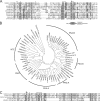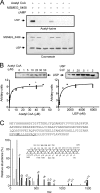cAMP-regulated protein lysine acetylases in mycobacteria
- PMID: 20507997
- PMCID: PMC2915667
- DOI: 10.1074/jbc.M110.118398
cAMP-regulated protein lysine acetylases in mycobacteria
Abstract
Cyclic AMP synthesized by Mycobacterium tuberculosis has been shown to play a role in pathogenesis. However, the high levels of intracellular cAMP found in both pathogenic and non-pathogenic mycobacteria suggest that additional and important biological processes are regulated by cAMP in these organisms. We describe here the biochemical characterization of novel cAMP-binding proteins in M. smegmatis and M. tuberculosis (MSMEG_5458 and Rv0998, respectively) that contain a cyclic nucleotide binding domain fused to a domain that shows similarity to the GNAT family of acetyltransferases. We detect protein lysine acetylation in mycobacteria and identify a universal stress protein (USP) as a substrate of MSMEG_5458. Acetylation of a lysine residue in USP is regulated by cAMP, and using a strain deleted for MSMEG_5458, we show that USP is indeed an in vivo substrate for MSMEG_5458. The Rv0998 protein shows a strict cAMP-dependent acetylation of USP, despite a lower affinity for cAMP than MSMEG_5458. Thus, this report not only represents the first demonstration of protein lysine acetylation in mycobacteria but also describes a unique functional interplay between a cyclic nucleotide binding domain and a protein acetyltransferase.
Figures







Similar articles
-
Cyclic AMP-dependent protein lysine acylation in mycobacteria regulates fatty acid and propionate metabolism.J Biol Chem. 2013 May 17;288(20):14114-14124. doi: 10.1074/jbc.M113.463992. Epub 2013 Apr 3. J Biol Chem. 2013. PMID: 23553634 Free PMC article.
-
Reversible acetylation and inactivation of Mycobacterium tuberculosis acetyl-CoA synthetase is dependent on cAMP.Biochemistry. 2011 Jul 5;50(26):5883-92. doi: 10.1021/bi200156t. Epub 2011 Jun 10. Biochemistry. 2011. PMID: 21627103 Free PMC article.
-
Cyclic AMP regulation of protein lysine acetylation in Mycobacterium tuberculosis.Nat Struct Mol Biol. 2012 Aug;19(8):811-8. doi: 10.1038/nsmb.2318. Epub 2012 Jul 8. Nat Struct Mol Biol. 2012. PMID: 22773105 Free PMC article.
-
Cyclic AMP Signaling in Mycobacteria.Microbiol Spectr. 2014 Apr;2(2). doi: 10.1128/microbiolspec.MGM2-0011-2013. Microbiol Spectr. 2014. PMID: 26105822 Review.
-
Cyclic AMP signalling in mycobacteria: redirecting the conversation with a common currency.Cell Microbiol. 2011 Mar;13(3):349-58. doi: 10.1111/j.1462-5822.2010.01562.x. Epub 2010 Dec 28. Cell Microbiol. 2011. PMID: 21199259 Free PMC article. Review.
Cited by
-
The myriad roles of cyclic AMP in microbial pathogens: from signal to sword.Nat Rev Microbiol. 2011 Nov 14;10(1):27-38. doi: 10.1038/nrmicro2688. Nat Rev Microbiol. 2011. PMID: 22080930 Free PMC article. Review.
-
Structural, kinetic and proteomic characterization of acetyl phosphate-dependent bacterial protein acetylation.PLoS One. 2014 Apr 22;9(4):e94816. doi: 10.1371/journal.pone.0094816. eCollection 2014. PLoS One. 2014. PMID: 24756028 Free PMC article.
-
Overexpression of the Rv0805 phosphodiesterase elicits a cAMP-independent transcriptional response.Tuberculosis (Edinb). 2013 Sep;93(5):492-500. doi: 10.1016/j.tube.2013.05.004. Epub 2013 Jul 6. Tuberculosis (Edinb). 2013. PMID: 23835087 Free PMC article.
-
Mycobacterium tuberculosis cell-wall and antimicrobial peptides: a mission impossible?Front Immunol. 2023 May 17;14:1194923. doi: 10.3389/fimmu.2023.1194923. eCollection 2023. Front Immunol. 2023. PMID: 37266428 Free PMC article. Review.
-
Structural and functional diversity of bacterial cyclic nucleotide perception by CRP proteins.Microlife. 2023 May 1;4:uqad024. doi: 10.1093/femsml/uqad024. eCollection 2023. Microlife. 2023. PMID: 37223727 Free PMC article. Review.
References
-
- Barzu O., Danchin A. (1994) Prog. Nucleic Acids Res. Mol. Biol. 49, 241–283 - PubMed
-
- Linder J. U., Schultz J. E. (2003) Cell Signal. 15, 1081–1089 - PubMed
-
- Shenoy A. R., Visweswariah S. S. (2006) FEBS Lett. 580, 3344–3352 - PubMed
-
- Shenoy A. R., Sreenath N., Podobnik M., Kovacevic M., Visweswariah S. S. (2005) Biochemistry 44, 15695–15704 - PubMed
Publication types
MeSH terms
Substances
LinkOut - more resources
Full Text Sources
Molecular Biology Databases

